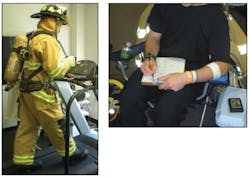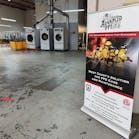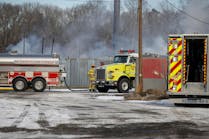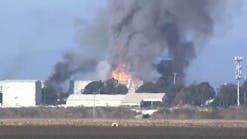Tools & Technologies: Base Layer Clothing: Part Of the Protective Ensemble
Turnout gear is essential for the safe performance of firefighting duties. Firefighters rely on the protective properties of their turnout gear and should be familiar with the use, care and limitations of that gear. Ironically, the same gear that protects the firefighter also imposes a physiological burden on the firefighter; specifically, the weight and insulative properties of turnout gear contribute to the cardiovascular and thermoregulatory strain experienced by a firefighter. National Fire Protection Association (NFPA) 1971, Standard on Protective Ensembles for Structural Firefighting and Proximity Firefighting, contains material performance requirements for the thermal protective performance (TPP) and total heat loss (THL) that must be provided by the gear.
While fire departments routinely put careful thought into the selection of their turnout gear, much less thought has typically been given to the clothing worn beneath the turnout gear, despite the fact that the station pants/shirt as well as the clothing worn next to the skin, the base layer, contribute to the thermal protection and burden experienced by the firefighter. In addition, the textile properties of the base layer may affect the performance and comfort of the firefighter. The base layer may be considered the foundation of the total protective ensemble that is worn by the firefighter. Thus, it is important to carefully consider the protection provided, the burden imposed, and the comfort of various base layers.
subhead
Many firefighters wear a standard cotton T-shirt; however, other materials/textiles have been promoted as being able to better wick sweat away from the body and lower skin temperature compared with 100% cotton T-shirts. These technical textiles are often marketed to athletes, who wear the garments as a single layer, and have recently been introduced to the military and fire service as providing potential benefit.
Several types of technical materials are reported to provide physiological benefits to the wearer under different conditions. Based on previous research, however, it is unclear if these technical materials would provide benefits when worn under turnout gear. Even if technical base layers do not provide an advantage during work cycles in full personal protective equipment (PPE), technical materials have the potential to be of benefit during planned rehabilitation periods of emergency operations when firefighters routinely doff their turnout gear. The purpose of this paper is to describe a research study that investigated differences in protection, physiological impact and comfort among four base layers.
In this research study, we examined the influence of the base layer material worn under structural turnout gear on physiological and perceptual strain during an alternating work/recovery protocol. The study also incorporated materials performance testing to determine how the inclusion of different base layers with turnout gear affected the performance measures (TPP and THL) required by the NFPA standard. For both types of testing (human performance and materials performance), all layers of clothing worn by the firefighter (base layer and structural turnout gear) were considered as part of an integrated clothing ensemble.
Research study
Ten male participants (average age of 21 years) were asked to complete an alternating work/recovery exercise protocol on four separate occasions. On each occasion, participants wore a different base layer material and station pants under firefighting turnout gear. The four base layer materials were chosen for their different properties, including flame resistance for the three technical base layers:
• Cotton – Low cost, user-accepted, comfortable, readily absorbs sweat, may dry slowly
• Modacrylic/rayon synthetic blend – Modacrylic is durable and has excellent fire resistant properties; rayon adds comfort as well as wicking properties and dries quicker than cotton
• Wool/rayon blend – Wool maintains a dry air space next to the skin, which keeps the wearer cooler in hot temperatures, and has excellent moisture absorption properties
• Phase change material (PCM) – Absorbs, stores and releases heat and has the potential to interact with the skin’s temperature to provide a buffer against temperature swings
Exercise protocol
The 110-minute protocol simulated a work/recovery cycle that may be experienced by a firefighter. The protocol included three 20-minute work bouts, during which participants walked on a treadmill at a moderate intensity level (approximately 70% of age-predicted maximum heart rate) while wearing PPE. which included G-XTREME turnout coat and pants from Globe Manufacturing Co., LLC, boots, flash hood, helmet, gloves and self-contained breathing apparatus (SCBA). Work bouts were followed by seated recovery periods of 10, 20 and 20 minutes, respectively. During recovery periods, fluid was provided, gear was doffed and a fan was used to actively cool participants as is often recommended during incident rehabilitation. Testing was performed in a thermoneutral laboratory (70 degrees Fahrenheit, 58.6% relative humidity).
Measurements
Throughout the protocol, heart rate (measured with a heart-rate monitor) and body temperature (measured with an ingestible pill) were recorded as measures of physiological strain. Thermal sensations were described on an eight-point scale from unbearably cold (0) to unbearably hot (8). Individual sensations, such as comfort, chafing and coolness/hotness, to the different base layers were also evaluated following the third exercise bout. Weights of the participant and articles of clothing were obtained before and after the protocol and sweat loss and sweat absorbed by the clothing were calculated.
As expected, all measures of strain increased during exercise and decreased during recovery in the physiological trials. However, the type of base layer had no effect on changes in heart rate, body temperature or thermal sensations. Based on previous research, it is not surprising that the technical base layers failed to provide an advantage when worn under turnout gear during exercise. Studies investigating the effect of different base layers worn under military PPE while performing moderate-intensity exercise in hot conditions have also reported no differences in physiological and perceptual responses. It appears that the high heat production during exercise when wearing protective clothing creates a condition in which the technical properties of the material are overwhelmed and fail to provide the proclaimed benefits.
In contrast to previous studies that investigated base layers worn under military PPE, most or all firefighting turnout gear was removed during the recovery periods in this study in order to be consistent with fire service practice during structured rehabilitation periods. Despite the removal of the turnout gear, which exposed the base layer to the ambient conditions, no differences in measures of physiological or perceptual strain were noted during recovery among the different base layers.
There were no differences in sweat loss while wearing different base layers; however, cotton and PCM absorbed significantly more sweat than modacrylic and wool. Differences in sweat retention may have influenced perceptions of clothing sensations. Immediately following exercise, participants indicated that compared with cotton, wool did not stick as much to the skin, was cooler and had a lower humidity sensation. Although both wool and modacrylic absorbed less sweat than cotton, no significant differences were found for any other sensations such as wetness or sweating sensation.
Materials Performance Testing
Materials performance testing of turnout gear is stipulated in NFPA 1971 and includes TPP and THL. TPP reflects the tolerance time of human skin to second-degree burn. The time (in seconds) to a second-degree burn is obtained by halving the TPP rating. The THL test measures the thermal and evaporative resistance of the clothing and combines these measures to yield a single number, the THL, to indicate the capability of the sample to dissipate heat.
In separate materials performance testing, the TPP and THL of the base layers were assessed individually and with turnout gear according to NFPA Standards and results are presented in Figure 4. The G-XTREME turnout gear had a TPP rating of 42 cal/cm2 and a THL of 266 W/m2, which meet the NFPA 1971 performance requirements of 35 cal/cm2 and 205 W/m2 for TPP and THL, respectively. The TPP and THL ratings for the base layers were obtained in combination with turnout gear to indicate the overall thermal protection and heat dissipation afforded by the integrated firefighting clothing ensemble. Cotton had a higher TPP than the technical layers but was also a heavier material (we had tried to match the weight of all material but could not match them exactly).
When base layers were considered along with the turnout gear, there was an increase in TPP (ranging from 9 to 14 cal/cm2) for the ensembles compared with turnout gear alone. The cotton-plus-turnout gear ensemble had a significantly higher TPP than modacrylic plus turnout gear, otherwise there were no significant differences in TPP among the ensembles. It is important to note that the turnout gear alone exceeded TPP requirements and the addition of the base layer further increased TPP.
Among THL comparisons, the THL of modacrylic plus turnout gear was significantly lower than the THL of cotton plus turnout gear and wool plus turnout gear. When only the base layer was considered, there were large differences in THL ratings, with PCM showing the greatest heat dissipation. Yet, even with THL ratings indicating that modacrylic and wool were able to dissipate approximately 45% less heat than PCM, there were no differences in thermoregulatory responses (body temperature) during the recovery periods of the human performance testing.
Conclusions
The base layer that is worn next to the firefighter is the foundational part of an ensemble that protects the firefighter. Thus, it is important to give careful consideration to the base layer that is worn, considering such aspects as the protection it affords, its functional properties and its comfort. This study found that the type of base layer worn under structural firefighting gear had little influence on physiological responses measured during exercise or recovery. This information is consistent with other research that suggests that when heavy clothing is worn during muscular work, the metabolic heat production and sweat production may overwhelm the properties of technical layers.
In contrast, the base layers did have different materials performance results. Importantly the phase change material had the greatest breathability (higher THL) of all the technical layers. This property may provide improved comfort over cotton under conditions of everyday wear. This is especially important to consider since the base layer is typically worn during an entire duty shift. Our results suggest that there are technical base layers that provide flame resistance that can be considered as appropriate base layers.
Acknowledgments
This study was supported by a research grant from the FEMA-Assistance to Firefighters Grant (AFG) (EMW-2009-FP-02044). The grant was awarded to Skidmore College with Globe Manufacturing Co. serving as a partner. We would like to express our appreciation for the expertise and services provided by Dr. Michael W. Dailey (Department of Emergency Medicine Albany Medical College) and the valuable assistance provided by Kathleen McNutt from Globe Manufacturing Co. in conducting materials performance testing. We would also like to acknowledge TenCate Protective Fabrics for performing the THL testing.
Denise L. Smith, Jeannie M. Haller, Eric M. Hultquist, Wesley K. Lefferts and Patricia C. Fehling, Ph.D. are affiliated with the First Responder Health and Safety Laboratory, Health and Exercise Sciences Department, Skidmore College, Saratoga Springs, NY.






